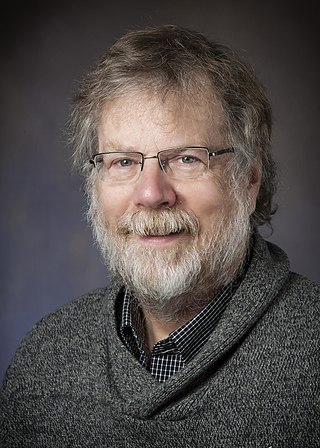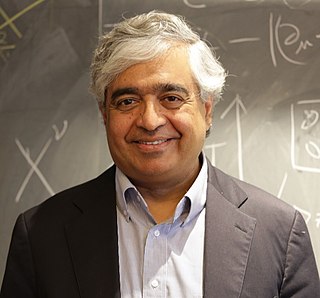Related Research Articles

Condensed matter physics is the field of physics that deals with the macroscopic and microscopic physical properties of matter, especially the solid and liquid phases, that arise from electromagnetic forces between atoms and electrons. More generally, the subject deals with condensed phases of matter: systems of many constituents with strong interactions among them. More exotic condensed phases include the superconducting phase exhibited by certain materials at extremely low cryogenic temperatures, the ferromagnetic and antiferromagnetic phases of spins on crystal lattices of atoms, the Bose–Einstein condensates found in ultracold atomic systems, and liquid crystals. Condensed matter physicists seek to understand the behavior of these phases by experiments to measure various material properties, and by applying the physical laws of quantum mechanics, electromagnetism, statistical mechanics, and other physics theories to develop mathematical models and predict the properties of extremely large groups of atoms.
Density functional theory (DFT) is a computational quantum mechanical modelling method used in physics, chemistry and materials science to investigate the electronic structure of many-body systems, in particular atoms, molecules, and the condensed phases. Using this theory, the properties of a many-electron system can be determined by using functionals, i.e. functions of another function. In the case of DFT, these are functionals of the spatially dependent electron density. DFT is among the most popular and versatile methods available in condensed-matter physics, computational physics, and computational chemistry.
Jellium, also known as the uniform electron gas (UEG) or homogeneous electron gas (HEG), is a quantum mechanical model of interacting electrons in a solid where the positive charges are assumed to be uniformly distributed in space; the electron density is a uniform quantity as well in space. This model allows one to focus on the effects in solids that occur due to the quantum nature of electrons and their mutual repulsive interactions without explicit introduction of the atomic lattice and structure making up a real material. Jellium is often used in solid-state physics as a simple model of delocalized electrons in a metal, where it can qualitatively reproduce features of real metals such as screening, plasmons, Wigner crystallization and Friedel oscillations.

Mott insulators are a class of materials that are expected to conduct electricity according to conventional band theories, but turn out to be insulators. These insulators fail to be correctly described by band theories of solids due to their strong electron–electron interactions, which are not considered in conventional band theory. A Mott transition is a transition from a metal to an insulator, driven by the strong interactions between electrons. One of the simplest models that can capture Mott transition is the Hubbard model.
The classical-map hypernetted-chain method is a method used in many-body theoretical physics for interacting uniform electron liquids in two and three dimensions, and for non-ideal plasmas. The method extends the famous hypernetted-chain method (HNC) introduced by J. M. J van Leeuwen et al. to quantum fluids as well. The classical HNC, together with the Percus–Yevick approximation, are the two pillars which bear the brunt of most calculations in the theory of interacting classical fluids. Also, HNC and PY have become important in providing basic reference schemes in the theory of fluids, and hence they are of great importance to the physics of many-particle systems.

In condensed matter physics, a string-net is an extended object whose collective behavior has been proposed as a physical mechanism for topological order by Michael A. Levin and Xiao-Gang Wen. A particular string-net model may involve only closed loops; or networks of oriented, labeled strings obeying branching rules given by some gauge group; or still more general networks.
Patrick A. Lee is a professor of physics at the Massachusetts Institute of Technology (MIT).

Xiao-Gang Wen is a Chinese-American physicist. He is a Cecil and Ida Green Professor of Physics at the Massachusetts Institute of Technology and Distinguished Visiting Research Chair at the Perimeter Institute for Theoretical Physics. His expertise is in condensed matter theory in strongly correlated electronic systems. In Oct. 2016, he was awarded the Oliver E. Buckley Condensed Matter Prize.

David Matthew Ceperley is a theoretical physicist in the physics department at the University of Illinois Urbana-Champaign or UIUC. He is a world expert in the area of Quantum Monte Carlo computations, a method of calculation that is generally recognised to provide accurate quantitative results for many-body problems described by quantum mechanics.

Subir Sachdev is Herchel Smith Professor of Physics at Harvard University specializing in condensed matter. He was elected to the U.S. National Academy of Sciences in 2014, received the Lars Onsager Prize from the American Physical Society and the Dirac Medal from the ICTP in 2018, and was elected Foreign Member of the Royal Society ForMemRS in 2023. He was a co-editor of the Annual Review of Condensed Matter Physics 2017–2019, and is Editor-in-Chief of Reports on Progress in Physics 2022-.
Yambo is a computer software package for studying many-body theory aspects of solids and molecule systems. It calculates the excited state properties of physical systems from first principles, e.g., from quantum mechanics law without the use of empirical data. It is an open-source software released under the GNU General Public License (GPL). However the main development repository is private and only a subset of the features available in the private repository are cloned into the public repository and thus distributed.

Piers Coleman is a British-born theoretical physicist, working in the field of theoretical condensed matter physics. Coleman is professor of physics at Rutgers University in New Jersey and at Royal Holloway, University of London.
Dieter Vollhardt is a German physicist and Professor of Theoretical Physics at the University of Augsburg.
Boris Ionovich Shklovskii is a theoretical physicist, at the William I Fine Theoretical Physics Institute, University of Minnesota, specializing in condensed matter. Shklovskii earned his A.B. degree in Physics, in 1966 and a Ph.D. in condensed matter theory, in 1968 from Leningrad University.
James P. Eisenstein is an American physicist noted for his experimental research on strongly interacting two-dimensional electron systems. He is currently the Frank J. Roshek Professor of Physics and Applied Physics, Emeritus, at the California Institute of Technology.
The Strictly-Correlated-Electrons (SCE) density functional theory approach, originally proposed by Michael Seidl, is a formulation of density functional theory, alternative to the widely used Kohn-Sham DFT, especially aimed at the study of strongly-correlated systems. The essential difference between the two approaches is the choice of the auxiliary system. In Kohn-Sham DFT this system is composed by non-interacting electrons, for which the kinetic energy can be calculated exactly and the interaction term has to be approximated. In SCE DFT, instead, the starting point is totally the opposite one: the auxiliary system has infinite electronic correlation and zero kinetic energy.

Antonio Helio de Castro Neto is a Brazilian-born physicist. He is the founder and director of the Centre for Advanced 2D Materials at the National University of Singapore. He is a condensed matter theorist known for his work in the theory of metals, magnets, superconductors, graphene and two-dimensional materials. He is a distinguished professor in the Departments of Materials Science Engineering, and Physics and a professor at the Department of Electrical and Computer Engineering. He was elected as a fellow of the American Physical Society in 2003. In 2011 he was elected as a fellow of the American Association for the Advancement of Science.
Elbio Rubén Dagotto is an Argentinian-American theoretical physicist and academic. He is a distinguished professor in the department of physics and astronomy at the University of Tennessee, Knoxville, and Distinguished Scientist in the Materials Science and Technology Division at the Oak Ridge National Laboratory.

Germán Sierra is a Spanish theoretical physicist, author, and academic. He is Professor of Research at the Institute of Theoretical Physics Autonomous University of Madrid-Spanish National Research Council.
Leo Radzihovsky is a Russian American condensed matter physicist and academic serving as a professor of Distinction in Physics at the University of Colorado Boulder.
References
- 1 2 Quantum Theory of the electron liquid, Cambridge University Press, 2005
- 1 2 Oxford University Press, 2011
- ↑ Vignale, G.; Rasolt, Mark (1987-11-16). "Density-functional theory in strong magnetic fields". Physical Review Letters. 59 (20). American Physical Society (APS): 2360–2363. Bibcode:1987PhRvL..59.2360V. doi:10.1103/physrevlett.59.2360. ISSN 0031-9007. PMID 10035523.
- ↑ Vignale, G.; Kohn, Walter (1996-09-02). "Current-Dependent Exchange-Correlation Potential for Dynamical Linear Response Theory". Physical Review Letters. 77 (10). American Physical Society (APS): 2037–2040. arXiv: cond-mat/9605052 . Bibcode:1996PhRvL..77.2037V. doi:10.1103/physrevlett.77.2037. ISSN 0031-9007. PMID 10061841. S2CID 3053337.
- ↑ D’Amico, Irene; Vignale, Giovanni (2000-08-15). "Theory of spin Coulomb drag in spin-polarized transport". Physical Review B. 62 (8). American Physical Society (APS): 4853–4857. Bibcode:2000PhRvB..62.4853D. doi:10.1103/physrevb.62.4853. hdl: 10355/7925 . ISSN 0163-1829.
- ↑ Weber, C. P.; Gedik, N.; Moore, J. E.; Orenstein, J.; Stephens, J.; Awschalom, D. D. (2005). "Observation of spin Coulomb drag in a two-dimensional electron gas". Nature. 437 (7063). Springer Science and Business Media LLC: 1330–1333. arXiv: cond-mat/0512032 . Bibcode:2005Natur.437.1330W. doi:10.1038/nature04206. ISSN 0028-0836. PMID 16251958. S2CID 4432183.
- ↑ Flatté, M. E.; Vignale, G. (2001-02-26). "Unipolar spin diodes and transistors". Applied Physics Letters. 78 (9). AIP Publishing: 1273–1275. arXiv: cond-mat/0012484 . Bibcode:2001ApPhL..78.1273F. doi:10.1063/1.1348317. hdl: 10355/7923 . ISSN 0003-6951. S2CID 15544179.
- ↑ US Patents No. 6,624,490 - 6,696,737 and 6,919,213
- ↑ Time is Alive/El Tiempo Esta' Vivo, El Zunzun Viajero, 2019
- 1 2 Odradek and Billy Bass Drink to the End of the World, El Zunzun Viajero, 2018